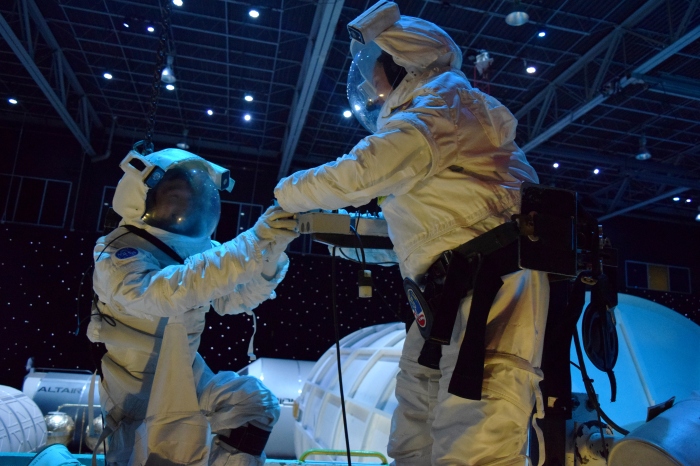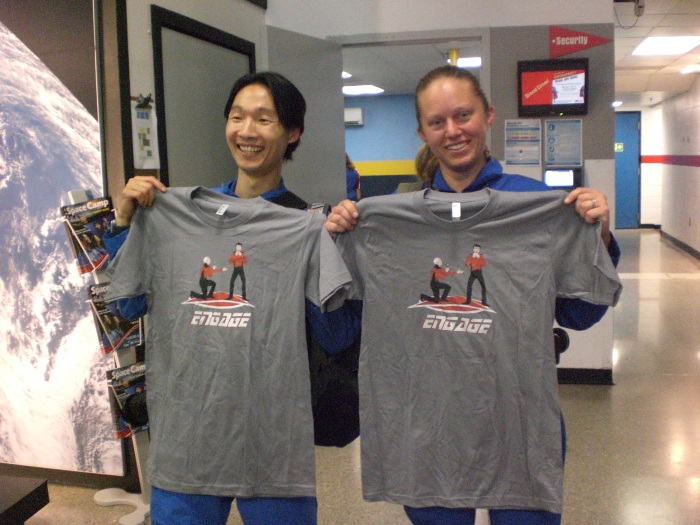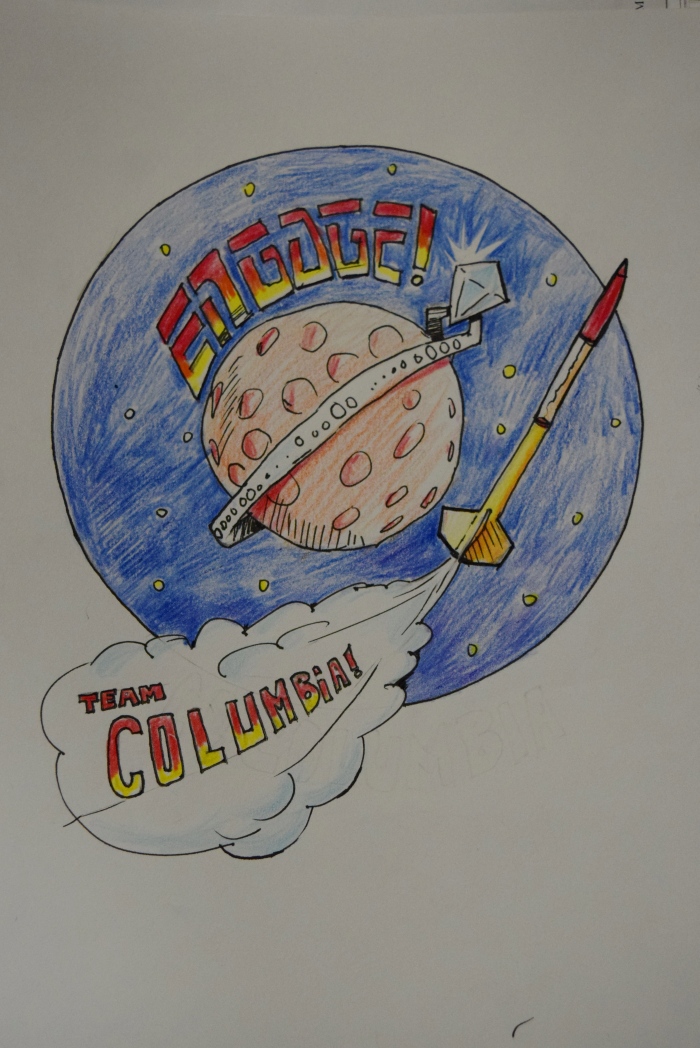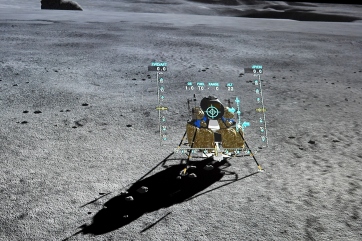Saturday! The day we get to have Space Camp all day long! The day’s activities began bright and early with a rocket launch. We had some trouble getting them going at first, but our ingenious crew trainers, Sarah and some other girl whose name I don’t know, did some trouble shooting, and they all eventually lifted off. Remember all that glue I used? Well, I held my breath hoping it would hold. My rocket went up, the parachute opened (somewhat), and then it came spiraling downward, only partially slowed by the partially opened chute. But the glue held! I wondered if I had somehow mispacked my parachute, even though “packing” it basically meant taking it out of the wrapping and not unfolding it. I followed those directions. Upon retrieval, however, I easily saw what had really happened (and had actually happened to several others’ chutes as well); the plastic parachute had melted together when the engine lighted. I didn’t stuff it way down in the rocket body, so the only fix I can think of is to use more wadding next time. It’s all just part of the fun of engineering, I suppose!

Rocket Launch
After the rocket launch, we headed off to complete our Alpha Mission, which we had trained so hard for the previous night. I diligently took my station at FDO and began reviewing my checklist. I kept a close eye on the mission clock, comparing the elapsed time to my list of what I should be checking, reporting, or calculating. I checked, I reported, everything was fine. Then I calculated the first engine burn to get the shuttle into the proper orbit. It turns out exactly the same every time, so I wasn’t really surprised by the answer. I reported this information at the specified time, but the shuttle computer wouldn’t accept the input. We tried again. And again. We tried a slightly different format. And another format. Then some warning lights came on and we had to deal with that. Then our flight director informed us that APU startup procedures still had not been completed, and that we should go back and finish those before working out that orbital maneuver. Seriously, does the APU ever work? We eventually decided to just skip that step and went back to working on getting that orbital maneuver completed with my calculations when Mike smugly announced that the EVA had been successfully completed. That’s nice, now please come help us out. Oh look, warning lights. Grrrr. We fixed it. Back to inputting those orbital maneuvers. Mike says, “Hey, everyone in Mission Control should check out that center screen.” The center screen showed Black Sheep and Future Husband. We’d already been informed that they had completed their mission, and they appeared to be packing up and getting ready to head back into the shuttle. That’s nice. Now about that orbital maneuver. . . Then once again, “Hey everyone, watch that center screen.” I glanced up again. Future Husband was down on one knee. Ooohhhhh! That’s not usually part of the mission. Orbital maneuvers were forgotten. We didn’t have any audio, but awwwwww. If you want to see the whole thing with some fuzzy audio, click here.

The Proposal
Even before the excitement had died down, it was time to land the shuttle. Let’s just say the happy couple didn’t make it back in one piece. Oh well. Best wishes to them anyhow.

That’s no way to land a shuttle!
By the time they had come out of the simulation area, the Mission Control crew had excitedly told team Discovery (who were waiting to begin their Alpha Mission) what had just happened. The happy couple was greeted by the enthusiastic congratulations of two teams, and the ISS crew was completely clueless as to what had just happened (but was quickly filled in). Mike came prepared with the nerdiest engagement gift ever, pictures ensued, and Black Sheep’s hand was passed around so that all could admire the beautiful ring that Future Husband had picked out.

Engage!

The Ring
Somehow Sarah managed to settle us down for our next task: designing a mission patch. We all jumped straight to engagement-themed ideas. It was quickly pointed out that some planets have rings, so we should put Black Sheep’s ring around a planet. Alex, our team artist, jumped right into sketching, trying to take suggestions from twelve people at once. Not sure how he processed all of that commotion, but he did. We threw out suggestions for ways to represent the rest of us, suggestions for a team motto, suggestions for colors, and suggestions for a wedding venue. The combined efforts of our suggestions and Alex’s “Good Idea Filter” came out wonderfully!

Team Columbia Mission Patch – Thanks to Alex!
Time flew in all of our excitement, and before we knew it, it was time to head out to the rocket park for the thrill rides! Black Sheep was able to go on the rides this time!! G-Force was first. It’s the centripetal force ride (if you’re standing in line measuring from an inertial frame of reference). There was a group of boy scouts in line ahead of us, and one of them had brought his Rubik’s Cube, which he planned to solve in the dim light whilst the centrifugal forces (since you’re in a rotating reference frame on the ride) smooshed his eyeballs into the back of his head and made it four times as difficult to lift his arms. I was surprised the staff didn’t think this was a safety issue, but they allowed the toy, and the boy surely did solve the puzzle!
Of course, we also had to try Space Shot, the vertical ride that shoots you up and pulls you back down several times. This one is one of my favorites! We got strapped in, and the ride seemed to get ready to fling us upward. Then it came back down and then seemed to get ready to fling us upward. Unfortunately, it didn’t. It was broken, so we’d just have to come back later. Rats.
After lunch, we had a chance to sit back and relax a bit. We went to see the IMAX movie “A Beautiful Planet,” which showed lots of space-views of our planet and talked to astronauts about life in space. Then Sarah shared a bit of shuttle history with us in the cafeteria before our next mission training. I tried to remember as much as possible because I knew Space Bowl was coming up, but it’s difficult when you don’t really have notes and three weeks to study like before a test in school.

Pathfinder was the first “shuttle” built. It is a test simulator made of steel and wood.
Next, it was time for our Bravo Mission training. This mission would not be the usual shuttle mission, but rather a lunar mission that involves the moon base called “Rising Star,” the space vehicle “Orion” which shuttles astronauts between Earth and the Moon, and the lunar lander “Altair,” which transfers astronauts from Orion in lunar orbit to the surface and back. The mission begins with four astronauts already on the Moon, and they have been there for a year. Orion brings up a new crew which takes Altair down to the surface, the old crew takes Altair back up to Orion, and Orion takes the weary travelers back to Earth.
I was thrilled to learn that I would be Lunar Specialist 2! That means I get to pretend to be on the Moon, and I get to wear a space suit. I would partner with Lunar Specialist 1 (Crystal) to venture outside Rising Star and complete a daily check of the batteries, electrical wiring, oxygen tanks, and nitrogen tanks before the new crew arrived. I thought this mission was quite a bit easier (probably designed for very young children) because it was extremely scripted. We really just had to follow along and read the words off a page. We learned our roles and then walked over to the museum for a docent tour.

The business end of a Saturn V rocket displayed in the museum
Now, I’m sure our docent was very knowledgeable, and he sure was excited about whatever it was he was talking about, but the museum just wasn’t set up very well for listening. We began our tour right next to a giant air conditioner. Being a warm Alabama July day, the system was in full swing. I didn’t catch much. Then we moved on to a spot right next to the launch simulator. It played a continuous loop of a rocket launch at full volume. I didn’t catch much of this part either. Our next stop was another corner of the room with another giant air conditioner. Ditto that first stop, except now my back was starting to hurt from all the standing. About halfway through the tour, we finally got to a point where I could hear decently, so I did get to learn a few things when I was able to ignore the increasing pain in my feet/knees/back. I got to see the Apollo 16 command module, and I learned what “hypergolic” fuel is. It’s two chemicals that automatically ignite when combined, no ignition spark needed. It was used in the Lunar Lander because ignition systems can fail. It’s a near-perfect guarantee that you will not get stranded on the Moon after landing, and the Lander included a primary way to mix the chemicals along with two back-up ways. I think hypergolic fuel was used in other places too, but I don’t recall exactly where.
We also saw a replica of Sky Lab, which turns out to have been made from the third stage of a Saturn V that was leftover after the Apollo program shut down (it was also delivered into orbit by a leftover Saturn V). It was a good use of spare parts if you ask me. They also had a mobile quarantine unit that was used after Apollo missions 11, 12, and 14 because they were afraid the astronauts might bring back space germs that would kill everyone on Earth. Story goes that it was being used as a bait and tackle shop in some far-out neck of the woods when someone recognized it as not-your-normal trailer. Said guy did some research and eventually contacted NASA when he was pretty sure of what it actually was. NASA was able to buy it back for museum display. NASA quit quarantining their astronauts after Apollo 14 because they realized there are no germs on the Moon. By now, I was getting really tired of standing. Dinner was a welcome invitation to sit down and rest!
After dinner, we went to a classroom where a crew trainer told us a bit about ablative vs. radiative heat shielding. You see, when a space craft reenters the Earth’s atmosphere, ram pressure and atmospheric friction generate a lot of heat, which will destroy the space vehicle and kill the occupants if not properly dissipated. Ablative heat shields work by absorbing the heat energy and then breaking off of the vehicle. The Apollo missions used this type of technology, and they are not reusable. The shuttle missions, however, were designed to be reusable. They used radiative heat shields. In this case, the material must be able to absorb heat and radiate it away quickly. You can heat up a shuttle tile to red hot temperatures and touch it immediately after removing the heat source without burning your hand because it cools so quickly.
With this explanation, it was then up to us to design a “thermal protection system” that would protect a raw egg from a blow torch (less than two inches away) for three minutes. We would lose points if the “eggstronaut” was scorched or cooked on the inside. We were also given a list of materials we could use and the “cost” of each material in credits. The goal was to design an effective, yet cheap, thermal protection system. It could use either ablative or radiative materials. Black sheep’s group included a materials engineer, so we figured they’d do well. However, their materials caught fire, just proving that even the experts need multiple iterations to test their contraptions. Their egg ended up a little scorched on the outside if I remember correctly. This little fire made my group a little nervous since we had used some of the same (flammable) materials. We quickly used our hands to tear some materials down to a smaller size and try to hide them completely behind the aluminum foil. Then we waited until the very end to test our system. We went out with a bang! Literally. Our egg exploded. We failed big time, but we did learn from other groups and given the chance to try again, I think we could do a better job. I might steal this idea for my classroom next year.
After destroying so many eggstronauts, we hoped our Bravo mission would be more successful. We suited up in our flight suits so that we would look awesome even if we died a horrible virtual death, and I headed over to Rising Star for the start of the mission. We checked our systems and communicated with Mission Control. Then Crystal and I put on our EVA suits and headed out the airlock to check the outside systems. One of us checked the O2 tanks while the other checked the N2, each finding one with zero pressure. We replaced them. Crystal checked the battery while I checked the wiring. There was a burnt wire, but it wasn’t connected to a battery, so we were okay for the moment. Unfortunately, one of the batteries was bad, so we had to replace it. Crystal hooked up the electrical leads while I put away the bad battery. I sure hoped the new crew was bringing fresh supplies for Rising Star because our equipment was failing fast! Nevertheless, our task was complete (in record time, according to our crew trainers).

Getting ready for daily maintenance with my fellow Lunar Specialist!

Crystal and I replace empty oxygen and nitrogen tanks during our lunar EVA
We headed back inside Rising Star to wait for the new crew. Because of our amazing maintenance skills, we had enough time left to try a couple of experiments! We put polyurethane part A and part B into a glove and waited for it to make foam. Oh how I love this exothermic reaction!! We put our materials away and played with the algae balls until the new crew arrived. I wonder where I can get some of those fuzzy little green things.

Altair touches down
Anyway, we crawled into Altair, read our lines, punched our buttons, and virtually lifted off to dock with Orion. The docking was successful, and we crawled through the hatch (not an easy task for the taller men in our group, mind you). Mike and Lindsay had to troubleshoot a couple of anomalies on the way back to Earth, but they got us safely home and we splash-landed in the ocean. It was good to be back after a whole year on the Moon!

Successful splash-down for Orion!
Whew! What a day! But we weren’t finished yet. We headed over to try our hand at the 1/6 chair, which simulates moon gravity. We bunny-hopped, we side-shuffled, and we slo-mo jogged. When it wasn’t our turn, we explored the Endeavor simulator, which I’m told was actually used by NASA for training real astronauts. Oooooo. Big toys! By the end of this, we were all pretty exhausted, but Sarah pointed us to some more Space Bowl information in our log books while we waited for the thunderstorm outside to pass.
We eventually made it back to Habitat 1 where our roommates from Discovery and Challenger learned that Black Sheep had been engaged for all of eight hours. Long hours of girl-talk followed, during which Black Sheep received much congratulations and way more relationship advice than she probably wanted. Showers and sleep eventually made their way into the picture, however. We couldn’t deny those for very long after the day we’d had!
-Pink Elephant
 “Space Camp All Day” by K. Mogren is licensed under a Creative Commons Attribution-NonCommercial-NoDerivatives 4.0 International License.
“Space Camp All Day” by K. Mogren is licensed under a Creative Commons Attribution-NonCommercial-NoDerivatives 4.0 International License.
“Rocket Launch,” “Proposal,” “Shuttle Crash,” “Mission Patch,” “Pathfinder,” “Saturn V Engine,” “Lunar Lander,” “Apollo 16,” “Thermal Protection Setup,” “Exploded Egg,” “Lunar Specialists,” “Lunar EVA,” “Altair,” “Orion Splashdown,” “Side Shuffle,” “Bunny Hop,” and “Slow Jog” are courtesy of Lisa Mogren and licensed under a Creative Commons Attribution-NonCommercial-NoDerivatives 4.0 International License.
Team Columbia Mission Patch was drawn by Alex F.






